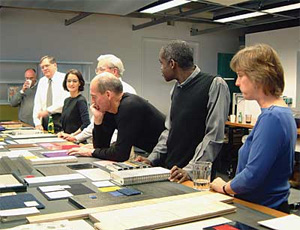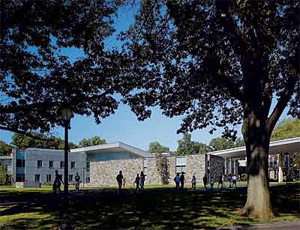Electronic mail may help in overseas working relationships, but it isn’t everything: design architects and their collaborating architects often place their respective staffs in each other’s offices during the phases of schematic design, design development, construction documentation, and construction supervision. Gruzen Samton, which associated with Bernard Tschumi, AIA (then dean of Columbia University’s Graduate School of Architecture, Preservation and Planning), for Columbia’s Lerner Hall [record, November 1999, page 94], sent architects to Tschumi’s office at the beginning of the schematic-design phase. “We were all looking at various alternatives, with lots of sketches,” says Samton. “Bernard had a lot of former students from Columbia who could work on one project at a time, 24/7.” During the middle of design development, Tschumi sent architects over to Gruzen Samton. “We use a form that indicates who is going to spend how many hours, with the rates and the profits. It was eye-opening to encounter design architects with the luxury of having more time per project, and staffed with young architects willing to work weekends and nights without extra pay.”


The sharing procedure gets more complicated if the star architect only has overseas offices. Bruce Fowle, FAIA, whose firm FXFowle (formerly Fox & Fowle) is the executive architect for Renzo Piano Building Workshop for the New York Times tower, now in construction in New York City, reports that the two firms set up a schedule where they would meet one month in Piano’s Paris office and the next month in FXFowle’s New York office. Piano placed two or three people in Fowle’s office in the construction document phase and at least one person in construction administration phase, mainly to check shop drawings.
A similar embedding of staff occurred when Beyer Blinder Belle (BBB), architects whose design reputation is built on the renovation of major landmarks, collaborated with Piano on the newly expanded Morgan Library and Museum. BBB had already come up with a master plan and programming for the Morgan in 1998, which also sought its expertise in restoring three historic buildings in the Morgan complex and in getting the project through potentially contentious landmark hearings. During the schematic design phase, BBB went to Piano’s office every six to eight weeks. At the end of the design development, BBB sent two people over for a week just to make sure the development drawings contained the amount of detail Americans like. During the construction document phase, visits reversed: Piano partner Giorgio Bianchi was in BBB’s office one week every month, and a younger architect from Piano’s office came to BBB full-time during this and the construction administration phase. Piano got more than half of the fees, BBB partner Richard Southwick, AIA, recalls. But then the Morgan had separate contracts with each architectural office, so that there was no prime architect (in the sense of holding the contract), nor a sub (in the sense of being paid by the architect who held the contract). Leo A Daly’s experience as executive architect to Rafael Moneo for the Cathedral of Our Lady of the Angels in Los Angeles [record, November 2002, page 124], included providing Moneo’s Madrid office with computers, recalls Leo A. Daly III, FAIA. “We also had a Spanish-speaking team from Daly working with Moneo in Madrid before the operation moved to our L.A. office.”
Terms of engagement
Obviously, collaborating architects such as Gruzen Samton , FXFowle, and Beyer Blinder Belle, all with solid design reputations in the commercial buildings, or in the case of BBB, restoration, would want a title that reflects the scope of its input. But the titles are ambiguous, and not systematically codified. Furthermore, they have been shifting in nuance over the past 30 or 40 years. In the old days, collaborating architects were called the architect of record, or the associate architect. It generally meant the architect stamped the drawings and acted as the local representative, while being liable for any failures in the building. And even though the design architect’s name came first, the architect of record or associate architect would usually hold the contract with the client. “The title ‘associate architect’ proved semantically fuzzy,” says BBB’s Southwick, although it sounds to him more involved in the process than architect of record.
But now executive architect is the “term du jour,” Southwick says, who thinks it implies a slightly larger role. (With the Morgan, the firm opted for both executive architect and architect of record.) Alex Ward, AIA, until recently with Leo A Daly, feels that associate architect typically means “two firms are sharing responsibility more equally from start to finish.” Firm principal Daly explains that his firm uses executive architect quite often: “We think of ourselves as the lead architect, since we take responsibility, and the design architect is the sub.” Doug Frey, AIA, of Herbert Lewis Kruse and Blunck in Des Moines observes that executive architect strikes some as better for marketing, even though his firm, HLKB, opted to be called architect of record on the Figge Museum in Davenport Iowa [record, November 2005, page 116], designed by English architect David Chipperfield. HLKB teamed up with Chipperfield again for the recently opened Des Moines Library, still with the same title. Executive architect sounds too administrative for Frey. “We had a hands-on kind of collaboration with Chipperfield,” he says.
When it comes to titles, it’s a ragoût ambigu, although architect of record clearly defines the party with the liability—and often the sole contract with the client. Another working relationship that is very defined but rare because of the hassle involved in setting it up is the joint venture, a legal entity in which the design architect and the collaborating architect form a separate business for their joint firms, which has its own contract with the client, its own accounting setup, plus highly detailed stipulations of the services provided by each party. In the Seattle Central Library [record, July 2004, page 98], Rem Koolhaas and his Rotterdam-based firm OMA hooked up with Seattle architects LMN in a joint venture. “It was Rem’s preference,” says LMN’s John Nesholm, FAIA, about the idea. “He wished to have both firms involved for the entire duration and felt the joint venture would assure this.” Nesholm wonders if the legal twinning is an unnecessary complication, and notes that when LMN Architects, a firm known for convention centers, works with architects outside Seattle, it is called the design architect, while “the other title is up to the home firm.”
Unusual titles appeared in the credits for the de Young Museum in San Francisco designed by Swiss architects Herzog & de Meuron [record, November 2005, page 104]. The Basel-based firm was called the primary design architect and Fong & Chan, with whom it associated, was labeled principal architect. No wonder things are confusing. David Fong insists the museum wanted the title to relate to Fong & Chan’s responsibilities. “We do large work on time, on budget, and with a tiny percentage of change orders because we know how to manage a project,” he emphasizes, explaining that the museum was naturally nervous about the budget. “The change orders for de Young were a low 2.8 percent—unheard of,” he adds.

